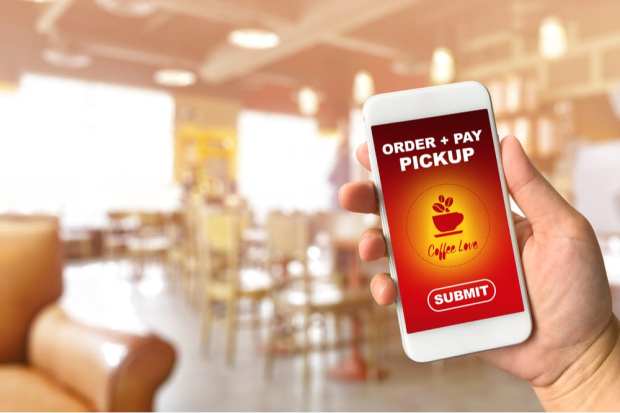How ResTech Pioneers Drive Dine-In, Pick Up And Order-Ahead Innovation

As mobile apps take hold in the quick-service restaurant (QSR) landscape, consumers are ordering their favorite foods for delivery. They are trading the experience of sitting down in a booth or at a table for the convenience of having their meals arrive at their doors with mobile technology that provides access to a variety of menu items with a few taps in the digital age.
Only 15 percent of restaurant meals are eaten on premises, according to the PYMNTS Mobile Order-Ahead Tracker, lower than 40 percent several years ago. The index notes, “This is largely due to the prevalence of delivery, which has increased 15 percent since 2018 likely thanks to the rise of mobile order-ahead apps.” But a study from the National Restaurant Association found that just 18 percent of restaurants offer mobile ordering via their own apps, while 43 percent of consumers want such methods.
Even so, innovators from third-party apps to restaurant chains themselves are offering mobile options that extend beyond delivery. These are just some of the ways that firms such as Chick-fil-A and Deliveroo are allowing consumers to order their favorite fare with a tap of the app for dine-in or pickup — as well as some of the latest challenges in the restaurant technology space.
The share of restaurants with in-house mobile ordering capabilities is 18 percent. Some restaurant chains, however, are adding their own mobile ordering features. Chick-fil-A, in one case, recently announced the rollout of dine-in mobile ordering. Consumers can access the dine-in mobile ordering option via its app. Once they select “mobile order,” the dine-in choice is listed next to the carry-out and drive-through options. When consumers arrive at the restaurants, they can check in by finding an open table and tapping the top of a smartphone to the table number when prompted. Khalilah Cooper, director of service and hospitality at Chick-fil-A, said in October, “We’ve received great feedback from parents because they have to think about placing an order for everyone in their family while waiting in line.”
The portion of QSR customers who are concerned that their online actions could be at risk for fraud is 62 percent. But despite their concern, according to one study, diners have also come to expect experiences that are quick and seamless. One of their top frustrations when placing mobile or online orders is a complex process for logging in and/or too many steps when it comes to accessing their account to make an order. Yet, more than half of survey respondents were worried that interactions with restaurants will lead to fraud, whether the case may be an account takeover (ATO), hijacked loyalty rewards points, bogus reviews, or stolen payment information. And close to half of the respondents were most worried about the theft of their credit card data, while a slightly smaller portion of respondents was worried about an ATO.
The portion of mobile order-ahead orders that are ready for pickup in less than two minutes is 58 percent. And food delivery services are rolling out options that let diners retrieve their orders from restaurants. U.K.-based on-demand food delivery service Deliveroo, in one case, is growing its platform to include a pickup option. The new Deliveroo service will be called Pickup and gives people a no delivery fee choice. The service is live in 13 U.K. cities and at more than 700 restaurants per reports in November. The plan is to offer the feature in 10,000 U.K. restaurants within one year. Restaurants still pay Deliveroo commissions with pickup orders — just less than they would with delivery. Deliveroo is offered in more than 500 cities across 13 markets — Australia, Hong Kong, Italy, Belgium and France, among others.
The current value of the eGift card market is $31.8 billion. And gift cards are a popular revenue stream for QSRs, which the index says is mainly due to the same reasons that they are popular with all sorts of retail companies. According to the index, gift cards “bring in new customers, promote loyalty among existing customers and create additional revenues when customers exceed the value of their gift cards.” This payment type has also become digital, for the most part, with the rise of tablets and smartphones. The value attached to the gift card market, however, has made these items prime targets for scammers. But QSRs, as well as retailers, are aiming to stop this tide of cybercrime by adopting anti-fraud measures.
The share of Chipotle’s Q3 sales generated by mobile ordering is 18.3 percent. And the QSR chain’s digital sales are on the rise, increasing 87.9 percent year over year in Q3. Total revenue rose 14.6 percent to $1.4 billion, the chain said, which met revenue expectations. CEO Brian Niccol said in the post-earnings conference call with investors, “We’re knocking on the door of digital becoming [a] $1 billion business. Consistent with past quarters, delivery remained a key driver of our digital growth, given enhanced capabilities on our app and website, as well as our expanded availability from more than 97 percent of our restaurants.” And, according to separate reports, Chipotle continues to roll out new “Chipotlanes.” The lanes allow customers to order and pre-pay online, and then pick up their orders at a designated time.
From Chipotle Mexican Grill to Chick-fil-A, restaurant chains — along with third-party platforms — are tapping into digital technology that brings consumers into brick-and-mortar restaurants to enjoy the convenience of pickup — or to rediscover the experience of sharing a meal in a dining room.
